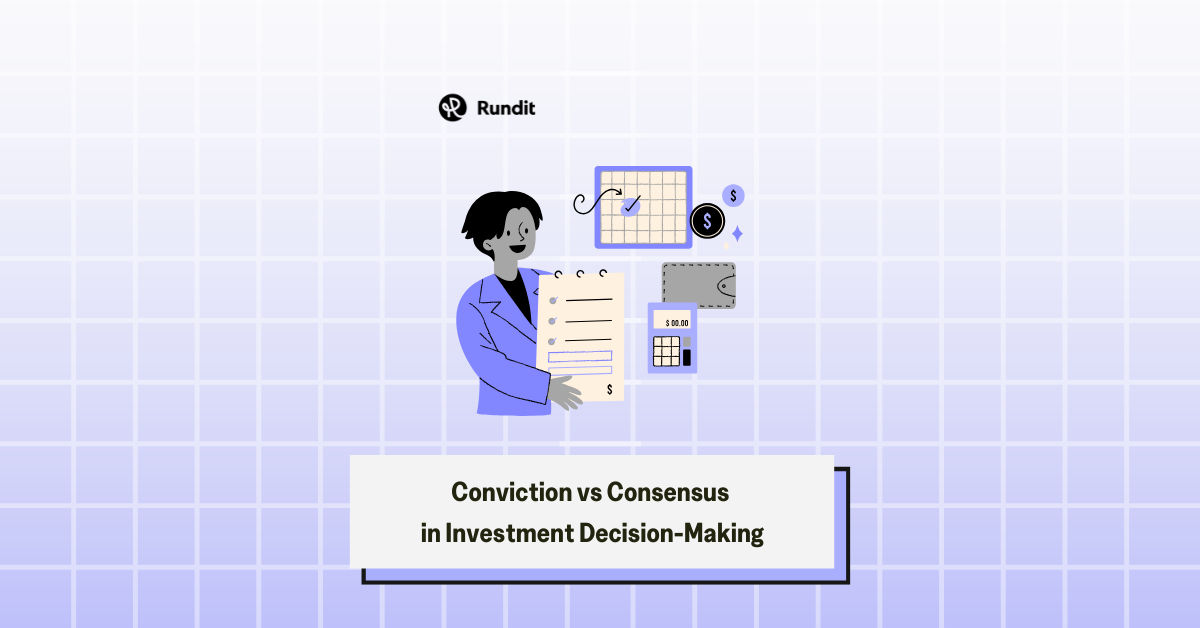
When making investment decisions, the age-old debate of “conviction vs. consensus” often takes centre stage. Should an investor trust their strong beliefs (conviction) about an opportunity, or should they align with the majority’s viewpoint (consensus)? Both approaches have their advantages and risks, and understanding the nuances between them is crucial for any investor aiming for long-term success.
In this blog, we’ll explore what each approach entails, discuss the benefits and drawbacks, and examine how to find the right balance between conviction and consensus decision-making.
Conviction in investing refers to the strong belief an investor has in a particular investment, often based on deep research, experience, or a unique insight that others may overlook. This approach requires confidence, independence of thought, and often a willingness to go against the grain.
1. Potential for Outsized Returns: If an investor’s conviction is correct and the market eventually comes around, the payoff can be substantial. Being early to identify undervalued assets or trends can lead to significant gains.
2. Focus and Clarity: Having strong conviction allows investors to focus on fewer investments, which can lead to a more in-depth understanding of each asset. This depth can enhance decision-making and portfolio management.
3. Resilience During Volatility: When markets are turbulent, investors with high conviction are often less likely to panic-sell, as their belief in the fundamental strength of their investment gives them the patience to ride out short-term fluctuations.
1. High Risk of Being Wrong: The flip side of conviction is the risk of overconfidence. If an investor’s analysis or assumptions are flawed, the consequences can be severe, especially if they have concentrated a significant portion of their portfolio in a few high-conviction bets.
2. Confirmation Bias: Investors may become so attached to their thesis that they ignore or downplay conflicting information, leading to poor decision-making.
3. Loneliness and Pressure: Investing against the crowd can be psychologically challenging. It requires strong mental fortitude to maintain a position when everyone else disagrees, and there is always the fear of missing out (FOMO) on seemingly safer, consensus-driven opportunities.
—

Consensus decision-making involves aligning with the majority view or prevailing market sentiment. This approach is often characterized by the belief that “the wisdom of the crowd” leads to more reliable outcomes.
1. Lower Risk: Aligning with consensus can mitigate risk, as the market’s collective intelligence often incorporates a wide range of perspectives and information. The consensus tends to reflect well-established trends or patterns, which can offer a degree of safety.
2. Reduced Emotional Burden: There is comfort in numbers. Consensus-driven decisions reduce the emotional burden of investing, as they are less likely to attract criticism or appear contrarian. This approach can be less stressful for investors who are averse to standing alone.
3. Market Efficiency: Consensus can reflect efficient market pricing. In many cases, prices already reflect all available information, meaning that aligning with consensus might avoid costly mistakes that arise from trying to outsmart the market.
1. Limited Upside Potential: When an investment is driven by consensus, it is often already priced in. This limits the potential for outsized returns since the “edge” is diminished by the wide agreement.
2. Herd Mentality Risks: Consensus can lead to herd behavior, where investors blindly follow trends without understanding the underlying fundamentals. This herd mentality can create bubbles or lead to panic-selling during downturns.
3. Slower Response to Change: By definition, consensus tends to be reactive rather than proactive. It often follows trends rather than setting them, which can mean missed opportunities in rapidly changing markets.
So, how does an investor navigate the tension between conviction and consensus? The answer lies in finding the right balance.
1. Conduct Thorough Research: Ground your conviction in rigorous research and data. This helps to reduce the risks associated with overconfidence and confirmation bias. At the same time, understand the prevailing market sentiment and consider why consensus may differ from your view.
2. Diversify Thought, Not Just Assets: While conviction investing may involve concentrated bets, ensure that your decision-making process involves diverse inputs. Seek out differing opinions and critically evaluate them to test your thesis.
3. Adopt a Flexible Mindset: Stay open to adjusting your views as new information emerges. A high-conviction investor should remain flexible enough to pivot if the facts no longer support their thesis.
4. Use Consensus as a Benchmark: Even if you lean towards conviction-based decisions, use consensus as a reference point to gauge market sentiment and timing. Understanding why the consensus exists can help refine your strategy and identify potential pitfalls or opportunities.
5. Maintain Emotional Discipline: Both conviction and consensus decision-making require emotional control. While conviction needs the courage to stay the course, consensus requires the discipline not to follow the crowd blindly.
The debate between conviction and consensus decision-making is not about choosing one over the other but about finding the appropriate mix for your investment style, risk tolerance, and market conditions. While conviction allows for potential outsized gains by going against the grain, consensus provides a buffer of safety by aligning with the collective wisdom of the market.
Ultimately, successful investing involves the ability to think independently while remaining aware of the broader market landscape. In a world filled with noise, the art lies in knowing when to listen to your inner voice and when to heed the wisdom of the crowd.
By blending conviction with an awareness of consensus, investors can position themselves to capitalize on unique opportunities while managing risk effectively. The right balance will vary for each investor, but the principles remain the same: be informed, be critical, and be adaptable. Utilizing tools like Rundit’s platform can further support this approach by offering comprehensive insights and streamlined portfolio management. The right balance will vary for each investor, but the principles remain the same: be informed, be critical, and be adaptable.
Additional sources
Make Decisions with a VC Mindset – Harvard Business Review
An Inside Look at how Venture Capital Firms Make Decisions – Origin Ventures